Basic knowledge of standard fasteners (5)
Part Three Nut
Chapter 1 Product Classification
1、 Product categories
(1) British Nut
1. According to ANSI/ASME B18.2.2, ANSI/ASME B18.6.3. (Mechanical Nuts) BSW916、JIS B 1181。
According to its characteristics, it can be divided into: ordinary nuts (FINISHED HEX NUTS) (1/4 or more including 1/4 specification) - FIN
Thin Nut (FINSHED HEX JAM NUTS) (1/4 or more including 1/4 specification) - JAM
Heavy duty Nut (1/4 or more including 1/4 specification) - HVY
Mechanical Screw Nuts (# 4-40-3/8 Specification) - M/S
2. The difference between American made nuts: ordinary, heavy-duty, and thin nuts can be manufactured in specifications of 1/4-1/2, while mechanical nuts can be manufactured in specifications of 3/8 or less. The main difference between imperial nuts is their thickness, and there are also slight differences on the opposite sides.
A、 Thin nuts have the same edge as regular nuts, but the thickness of thin nuts is smaller than that of regular nuts.
B、 Mechanical nuts have larger edges than regular nuts, thicker than thin nuts, and smaller than regular nuts.
C、 Heavy duty nuts have larger edges and thicker thickness than mechanical nuts, with a thickness slightly smaller than the nominal diameter.
Taking the 3/8 nut as an example:

3. The difference between British Vickers thread nuts (BSW916 and JIS B 1181):
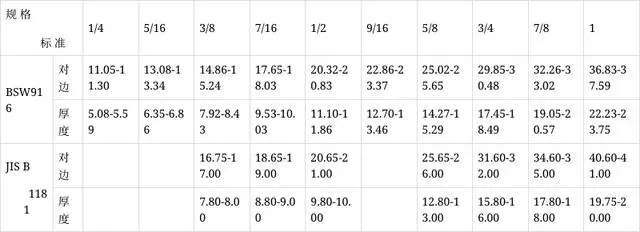
(2) Metric Nut
Note: The dimensions in the table are all upper limit specifications. Differences in Standards: Old National Standard, New National Standard, International Standard, German Standard, Italian Standard
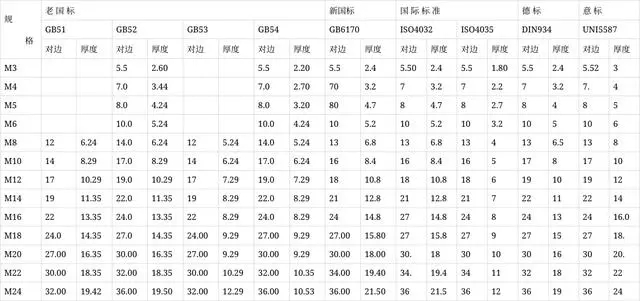
Note: The dimensions in the table are all upper limit specifications.
2. The reference standards are as follows

2、 Product identification:
(1) Diagram of various parts of the nut:
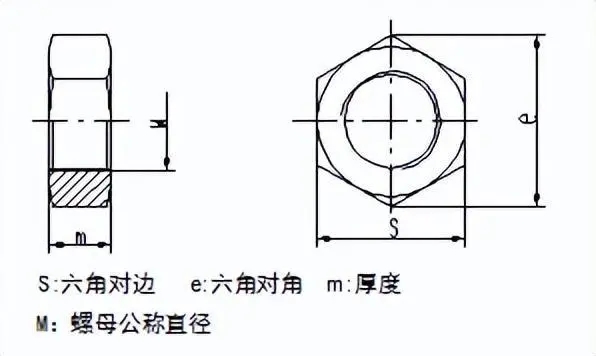
Example of American standard nut notation:
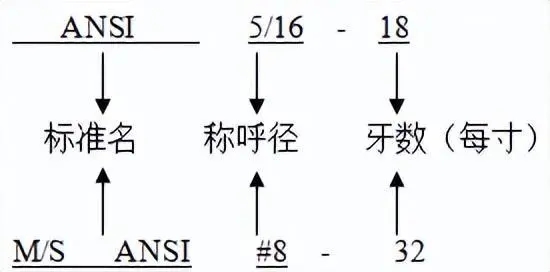
German Standard Example (National Standard, ISO Standard are basically the same):
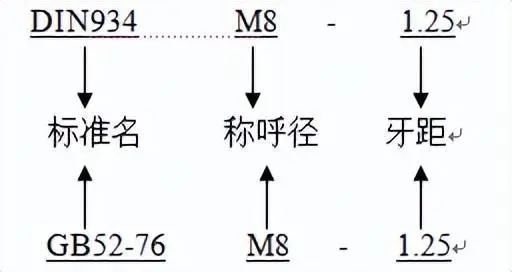
3、 Performance level:
Nuts with performance levels ≥ 8 and 05 must be marked with concave characters on their supporting surface or side, or convex characters on their chamfered surface, and only hexagonal nuts with thread diameter ≥ 5mm need to be marked.
4、 Types of nut threads
(1) There are many types of threads developed for various countries. Currently, our company produces the following types of threads:
M - metric coarse teeth, fine teeth, extremely fine teeth
UNC - Union Coarse Teeth (Imperial)
UNF - Joint Fine Teeth (Imperial)
W - Webster's coarse and fine teeth (JIS)
In addition, there are also 8-thread series (8-UN) and 12 thread series (12-UN) in the imperial system.
(2) Thread accuracy grade:
The metric system (DIN, ISO, GB) is divided into 6H and 6G levels. Normally, it is at level 6H. The metric Japanese standard (JIS) is divided into three types: Level I, Level II, and Level III. The usual condition is level II.
2. The British system is usually classified as 1B, 2B, and 3B, and is typically classified as 2B level.
3. At present, there are two types of tooth angles used for dental attacks: 600 and 550. 600 has metric teeth, British UNC UNF, etc., while 550 has Webster teeth, BSW, BSF, etc.
4. The main geometric parameters of threads are: thread diameter, pitch, pitch, and pitch angle. The above points all affect the thread accuracy, as described in the first part.
Requirements for hot-dip galvanized nuts:
Due to the thick electroplating layer (usually above 40um) of hot-dip galvanizing, considering its impact on thread accuracy, the aperture of hot-dip galvanized nuts must be slightly larger than that of general nuts during molding. Our specific requirements are as follows:

2. The upper limit of the final control size for edge and thickness is increased by 0.5mm compared to the upper limit of the specification.
Chapter 2 Process Flow
1、 Production process:
(1) Nuts below level 8

(2) Grade 8 nut

(3) Grade 10 and 12 in metric system, Grade 5 or above in imperial system nuts

(4) Nuts for metric grades 10 and 12, and imperial grades 5 and above:

2、 Please refer to the fifth section for a detailed introduction of each process.
Chapter 3 Mechanical Properties
The mechanical properties of the product are based on:
(1) The mechanical property inspection of DIN products shall be carried out in accordance with DIN267.4.
(2) The mechanical property inspection of ISO products shall be carried out in accordance with ISO898.2.
(3) The mechanical property inspection of GB products shall be carried out in accordance with GB3098.2.
(4) The mechanical property inspection of products in ANSI/ASMEB18.2.2 shall be carried out in accordance with SAE J995 and ASTM A563.
(5) The mechanical property inspection of JIS B1181 products shall be carried out in accordance with JISB1052.
Identification of performance levels and mechanical property requirements:
(1) GB3098.2:
Equivalent use of ISO898.2 is applicable for carbon steel or alloy steel manufacturing, with a nominal height ≥ 0.5D, and a coarse thread 6H nut with a guaranteed load and a thread diameter of 3-39mm needs to be specified.
1. Tag:
(1) Marking method:
A nut with a nominal height greater than or equal to 8D shall be marked with the first part of the bolt performance grade number. The bolt shall be the highest performance grade bolt that can be matched with the nut. The matching grade between the bolt and nut during use is as follows:

Nut with a nominal height greater than or equal to 0.5D but less than 0.8D: used for "O" and a numerical mark, where the number represents 1/100 of the guaranteed stress measured with a quenched hard core rod, and "O" indicates that the actual load-bearing capacity of this nut assembly is lower than the load-bearing capacity represented by the number, such as level 04 or 05.
(2) Grade: The mechanical performance grade of metric nuts can be divided into four levels: 04, 05, 4, 5, 6, 8, 9, 10, and 12.
2. Mechanical performance requirements: Conduct mechanical performance testing according to the method specified in GB3098.2, and meet the corresponding requirements in the following table: see: bolts, screws, and studs: "Fastener Foundation" GB | T3098.2-2000, pages 61-81, tables 1 to 16. Mother: Tables 1 to 7 on pages 83 to 98 of "Fastener Fundamentals" GB | T 3098.2-2000.
3. Usually, when bolts and nuts are used together, the following failure modes may occur: A. Screw fracture. B、 The thread of the screw is loose. C、 The thread of the nut is loose. D、 The threads of the nut and screw are both loose. Due to the sudden occurrence of screw fracture. It is relatively easy to notice that detachment occurs gradually and is difficult to detect, so in the design of threaded connections, it is always hoped that the failure will be caused by screw fracture.
SAE J995 (Steel Nut Steel Nut):
This standard covers the mechanical properties and material requirements for three grades of nuts suitable for use in automobiles and related engineering applications, with sizes ranging from 1/4 to 1 1/2 inch (inclusive).
1. Tag:
Grade 2 nuts do not require any grade identification. Unless otherwise specified by the customer. Grade 5 and Grade 8 hex nuts, with specifications ranging from 1/4 to 1 1/2 inches, must have grade identification markings.
2. Mechanical performance requirements: The nut should meet the corresponding mechanical performance requirements in the table below according to the type, grade, and specifications of the product:
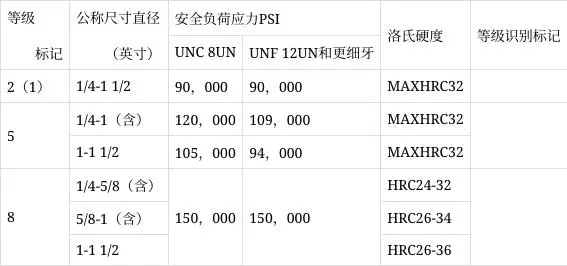
Note: (1) Level 2 is usually only applicable to Square Nuts, and Square Nuts are usually only used for Level 2.
ASTM A563 (Carbon Steel, Alloy Steel Nuts)
This standard applies to eight grades of carbon steel and alloy steel nuts used for general structural and mechanical bolts, studs, and other externally threaded components
Tag:
(1) Marking method:
① Nuts that meet the requirements of O, A, and B grades do not need to be marked unless specifically requested by the order.
② The markings for nuts of other grades are detailed in the table below.
(2) Grade: The mechanical properties of the nut can include Grade O, Grade A, Grade B, Grade C, Grade C3, Grade D, Grade DH, and Grade DH3.
2. Mechanical performance level: The product undergoes mechanical performance testing according to the ASTM A563 method and meets the corresponding requirements below.
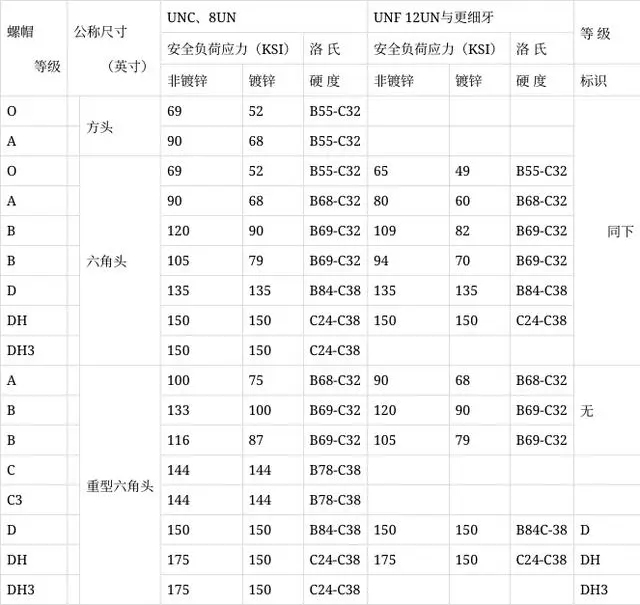
3、 Mechanical property testing method:
(1) Safety load: The nut must be combined with the test bolt or hardened threaded shaft, and the safety load specified by the nut must be applied axially to the nut. The hardness of the shaft must be at least C45 according to the Dalloway hardness, and the thread must have a tolerance of 3A level. In addition, its outer diameter must be the minimum outer diameter plus a tolerance of 0.002 inches.
1. ISO898.1 (GB3098.1) stipulates that the movement speed of the clamp during testing should not exceed 3mm/min and should last for 15 seconds. According to ASTM F606M, the movement speed of the clamp during testing should not exceed 1.0 in/min (25mm/min), and the load duration should be 10 seconds.
2. During the experiment, the nut must be able to withstand the load without slipping or breaking. After removing the load, the nut can be loosened by hand or with the help of a wrench, but not more than half a turn.
(2) Heart hardness: The hardness test should be conducted horizontally from half the height of the nut, and the measurement point should be located at the midpoint of the outer diameter of the tooth and one corner on the bearing surface. It can also be taken at a distance of one-third from the center point of the opposite side to any corner. The average of at least two hardness test values from two 1800 diagonals is taken as the hardness value of the nut. Surface cleaning should remove any oxides, decarburization layers, coatings, and other surface debris.

5 Comments